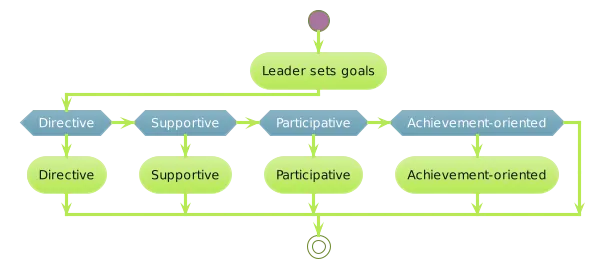Introduction
The path-goal theory is a leadership approach that focuses on the behavior style of leaders and considers the situation and the needs of employees in the work environment.
It was established by Evans and further developed by House. According to this theory, leaders play a supportive role rather than simply exerting power over their subordinates.
They are responsible for defining clear goals, providing support in task performance, and rewarding successful achievement of those goals.
The theory is based on the motivation theory developed by Vroom, known as the expectancy theory.
According to this theory, employees are motivated when they believe they are capable of completing a task, when they believe their efforts will lead to success, and when they believe the rewards are aligned with their efforts.
4 Leadership Styles
The path-goal theory identifies four leadership styles that leaders can adopt: directive, participative, supportive, and achievement-oriented.

Directive style, leaders provide clear instructions and guidance to their subordinates. They let them know what is expected of them and how tasks should be performed.
This style is effective when subordinates need structure and guidance to complete their work.
Participative style involves consulting with subordinates when facing problems and listening to their ideas and suggestions.
Leaders who adopt this style value the input and involvement of their subordinates in decision-making processes. This style is effective when subordinates have valuable insights and expertise to contribute.
Supportive style focuses on maintaining a friendly working relationship with subordinates and addressing their personal needs.
Leaders who adopt this style show concern for the welfare of their subordinates and create a pleasant work environment. This style is effective when subordinates need emotional support and encouragement.
Achievement-oriented style involves setting challenging goals for subordinates and expecting them to perform at their highest level.
Leaders who adopt this style have high expectations and provide subordinates with the conviction that they can meet those expectations. This style is effective when subordinates are motivated by challenging tasks and strive for achievement.
The path-goal theory also takes into account the characteristics of the work environment, such as the characteristics of the workgroup, task structure, and formal authority system. Additionally, it considers the characteristics, abilities, and needs of the subordinates.
House’s path goal theory
House’s path-goal theory is a leadership theory that focuses on how leaders can motivate and guide their followers to achieve their goals. Developed by Robert House, this theory suggests that leaders can enhance their followers’ performance and satisfaction by adopting different leadership styles and behaviors.
In summary, the path-goal theory is a leadership approach that emphasizes the behavior style of leaders and the importance of considering the situation and the needs of employees.
It provides leaders with guidelines on how to define clear goals, provide support, and reward successful achievement of those goals.
By adopting different leadership styles based on the needs of their subordinates, leaders can effectively motivate and guide their teams towards achieving common goals.
Was this helpful?
0 / 0